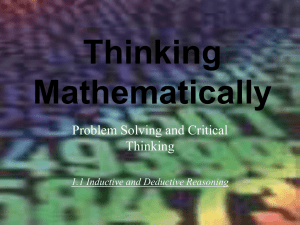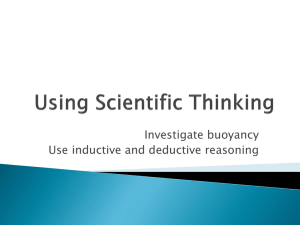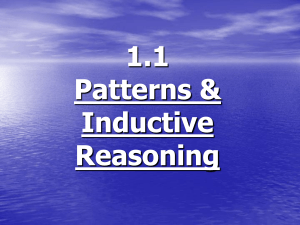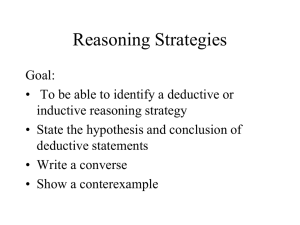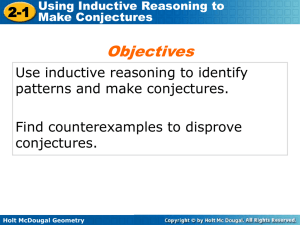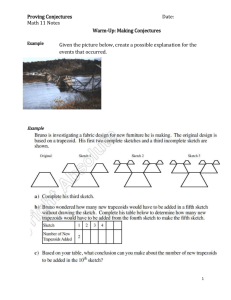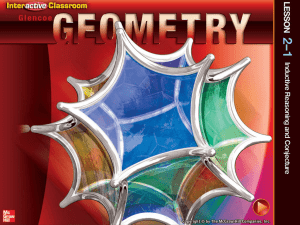Survey of Mathematical Ideas Math 100 Chapter 1
advertisement
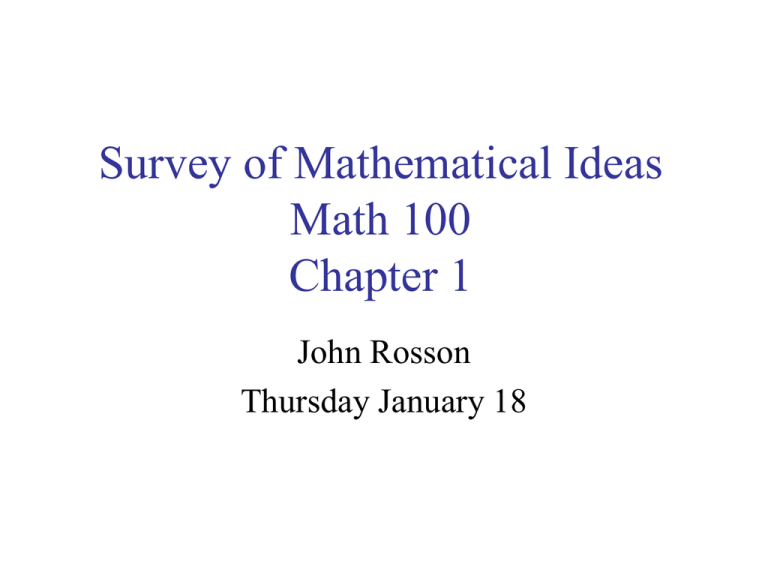
Survey of Mathematical Ideas Math 100 Chapter 1 John Rosson Thursday January 18 Chapter 1 The Art of Problem Solving 1. 2. 3. 4. Solving Problems by Inductive Reasoning Number Patterns Strategies for Problem Solving Calculating, Estimating and Reading Graphs Inductive Reasoning Inductive reasoning is characterized by drawing a general conclusion (making a conjecture) from repeated observation of specific examples. The conjecture may or may not be true. Specific General Inductive Reasoning • Last year was a bad hurricane season and so was this year. Therefore next year will be a bad hurricane season. • In decimals, the number starts 3.1415. Therefore the next two digits in are 16. • The sun has come up every day for as long as anyone remembers. Therefore it will come up tomorrow. • The Cubs will not win the World Series. • Any reasoning of a general scientific or philosophical law or principle directly from data or experience is inductive reasoning. Inductive Reasoning; An Example The following is the sequence of squares of whole numbers: 1 4 9 16 25 36 49 64 81 100 Look at consecutive differences: 4 1 9 4 16 9 25 16 3 5 36 25 49 36 64 49 81 64 100 81 7 9 11 13 15 17 19 Conjecture: Starting with 1 you get the sequence of squares by adding the sequence of odd numbers. 1 1 4 1 3 9 1 3 5 16 1 3 5 7 This conjecture turns out to be true. etc. Inductive Reasoning; An Example A prime number is a positive whole number larger than 1 that is evenly divisible only by 1 and itself. Here are the positive whole numbers with the primes highlighted. 1, 2, 3, 4, 5, 6, 7, 8, ….. Conjecture: All odd numbers greater than 1 are prime. This conjecture turns out to be false since the next odd number 9 is evenly divisible by 3 and therefore not prime. Since 9 shows the conjecture to be false, 9 is called a counterexample to the conjecture. Deductive Reasoning Deductive reasoning is characterized by applying general principles to specific examples. Specific General Premise Logical Argument Calculation Proof Conclusion Deductive Reasoning. • It is raining or cloudy. Therefore it is not sunny and dry. • If a miracle happens the Cubs will win the World Series. • All mathematical facts (theorems rather than conjectures) are the result of deductive reasoning. • Any reasoning of a scientific or philosophical law or principle directly from first principles or assumptions. Deductive Reasoning; An Example In calculations the general principles are the rules of arithmetic and algebra. Theorem: If 3 x 6 then x 2 Proof: 3 x 6 Premise 1 1 3x 6 3 3 3x 6 3 3 1 x 2 x 2 Conclusion Thus the theorem is true. Deductive Reasoning; An Example h Theorem: If the legs of a right triangle are 2 and 3 respectively then the hypotenuse h 13 . 3 2 2 2 Proof: a b c 32 2 2 h 2 2 Pythagorean Theorem Premise 9 4 h2 13 h 2 13 h 13 h Conclusion Inductive and Deductive Reasoning We used inductive reasoning to get: Conjecture: Starting with 1 you get the sequence of squares by adding the sequence of odd numbers. That is n2 1 3 5 (2n 1) We now use deductive reasoning to get: Theorem: For every positive whole number n n2 1 3 5 (2n 1) Inductive and Deductive Reasoning Theorem: For every positive whole number n n2 1 3 5 (2n 1) Proof: 12 2 1 1 1 (n 1) 2 1 3 5 (2(n 1) 1) Premise n 2 2n 1 1 3 5 (2n 3) n 2 1 3 5 (2n 3) (2n 1) Conclusion Inductive and Deductive Reasoning Summary • First use inductive reasoning to develop a conjecture. • Second use deductive reasoning to validate or prove the conjecture. Number Patterns: Successive Differences Problem: Given a sequence of numbers, say 2, 57, 220, 575, 1230, 2317,…. determine (a good guess for) the next number in the sequence. This is an inductive form of argument since there is no guarantee what the next number will be. Number Patterns: Successive Differences The method of successive difference tries to find a pattern in a sequence by taking successive differences until a pattern is found and then working backwards. 2 57 220 575 1230 2317 …. 55 163 355 655 1087 …. 108 192 300 432 …. 84 108 132 …. 24 24 …. Number Patterns: Successive Differences Fill in the obvious pattern and work backwards by adding. 2 57 220 575 1230 2317 3992 55 163 355 655 1087 1675 108 192 300 432 588 84 108 132 156 24 24 24 The method of successive differences predicts 3992 to be the next number in the sequence. Number Patterns: Successive Differences The method of successive differences is not always helpful. Consider 1 2 3 5 8 13 21 34 55 89 144 233 377 610 987 1597 …. 1 1 2 3 5 8 13 21 34 55 89 144 233 377 610 …. 0 1 1 2 3 5 8 13 21 34 55 89 144 233 …. 1 0 1 1 2 3 5 8 13 21 34 55 89 …. Since the sequence reproduces itself after applying successive differences, the method can give us no simplification. Assignments 1.2, 1.3, 1.4, 2.1, 2.2 Read Section 1.2 Due January 23 Exercises p. 16 1-5, 15, 21, 33, 34 Read Section 1.3 Due January 23 Exercises p. 25 1, 10, 19, 21, 27, 40 Read Section 1.4 Due January 23 Exercises p. 35 10-15 Read Section 2.1 Due January 25 Exercises p. 54 1-8, 21-28, 33-40, 41-50, and 67-76 Read Section 2.2 Due January 25 Exercises p. 61 1-6, 23-42, 44, 49-54
